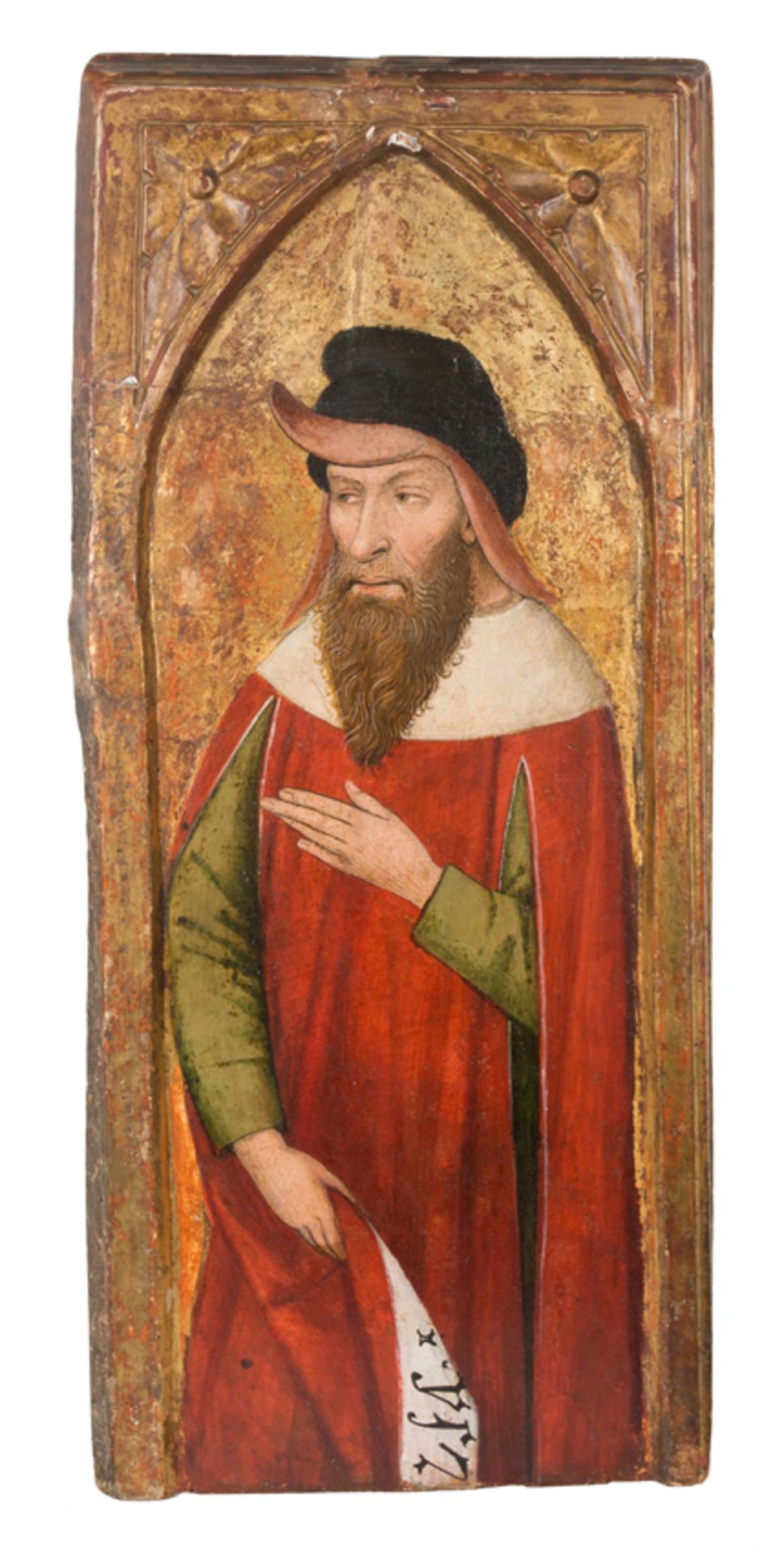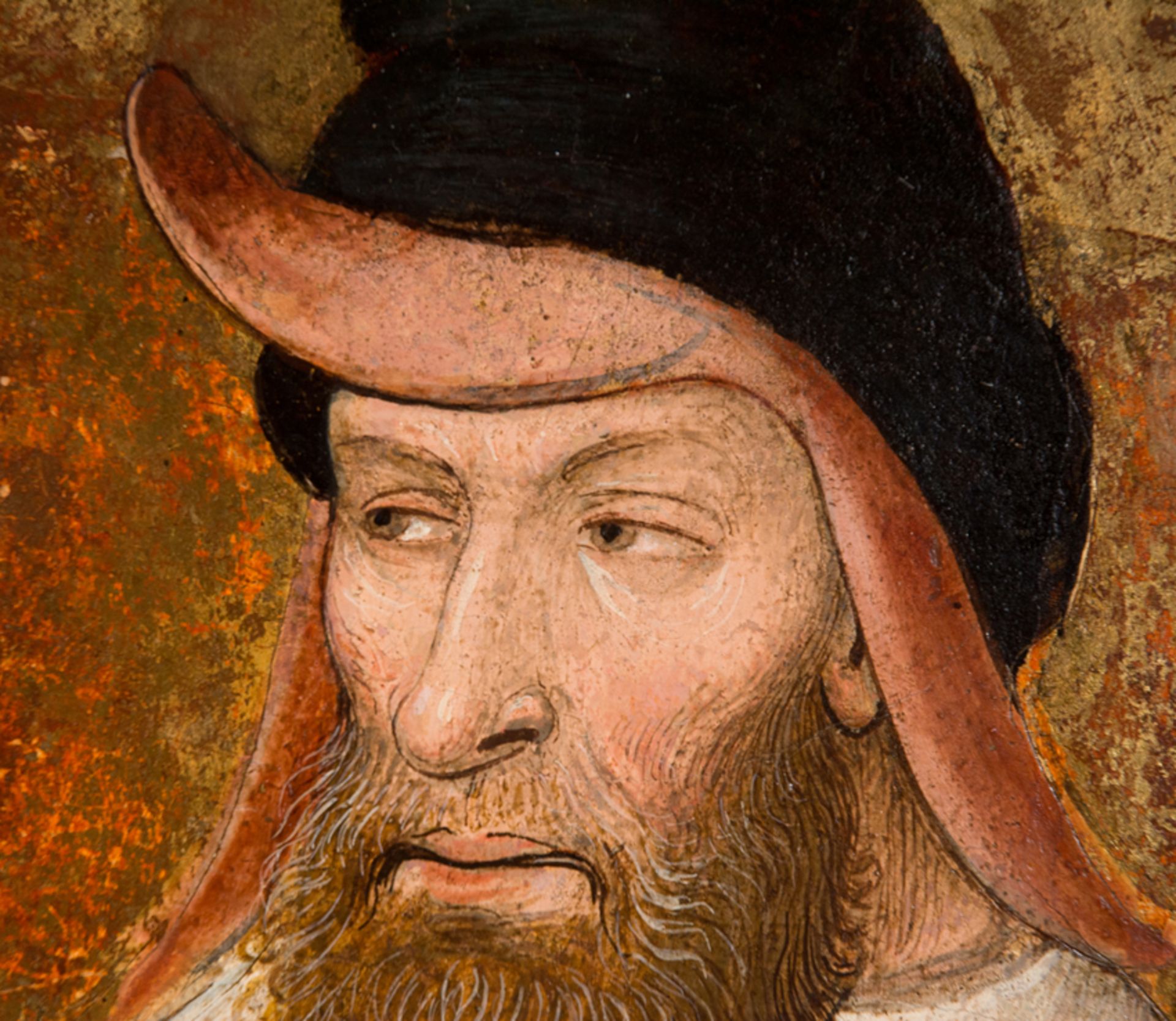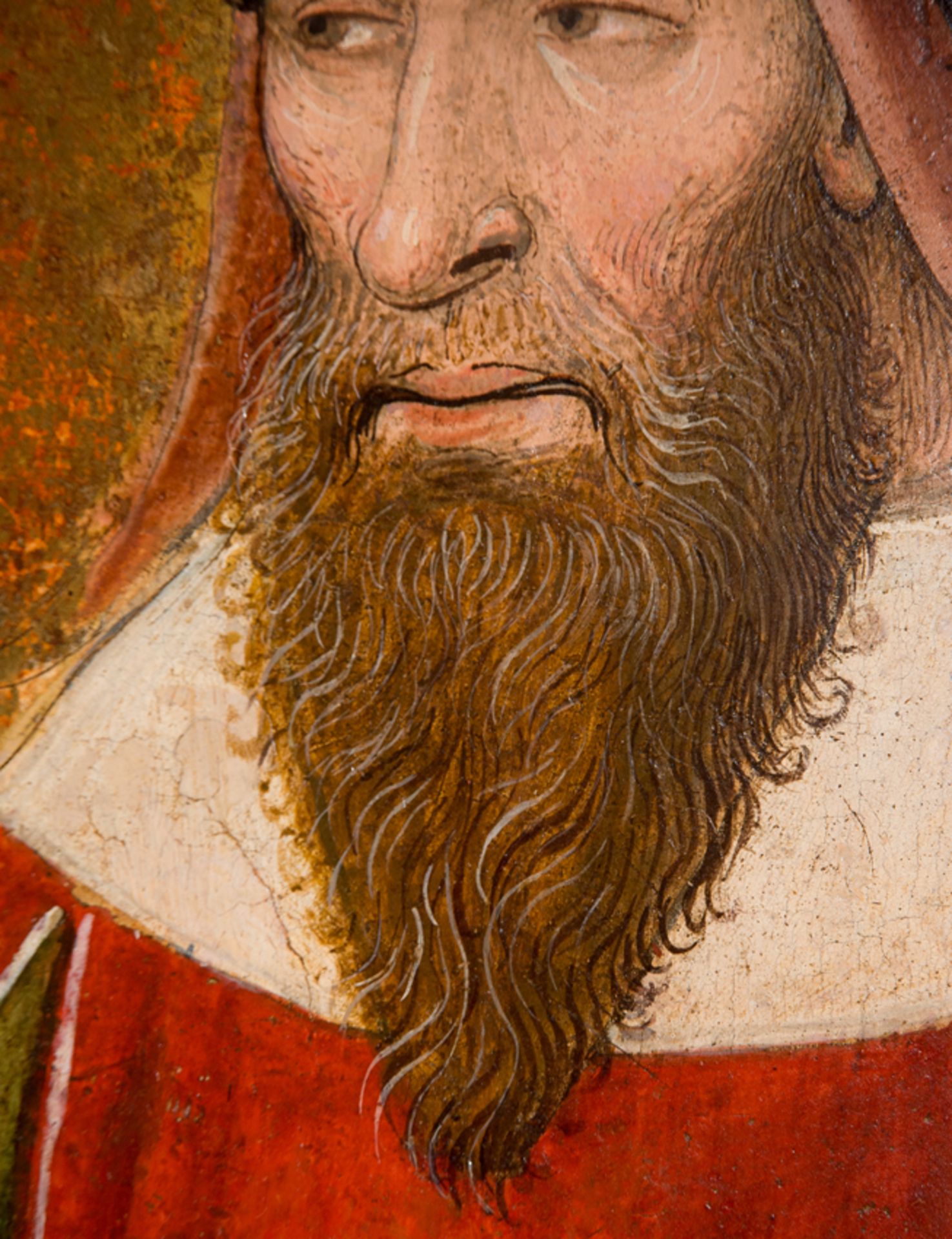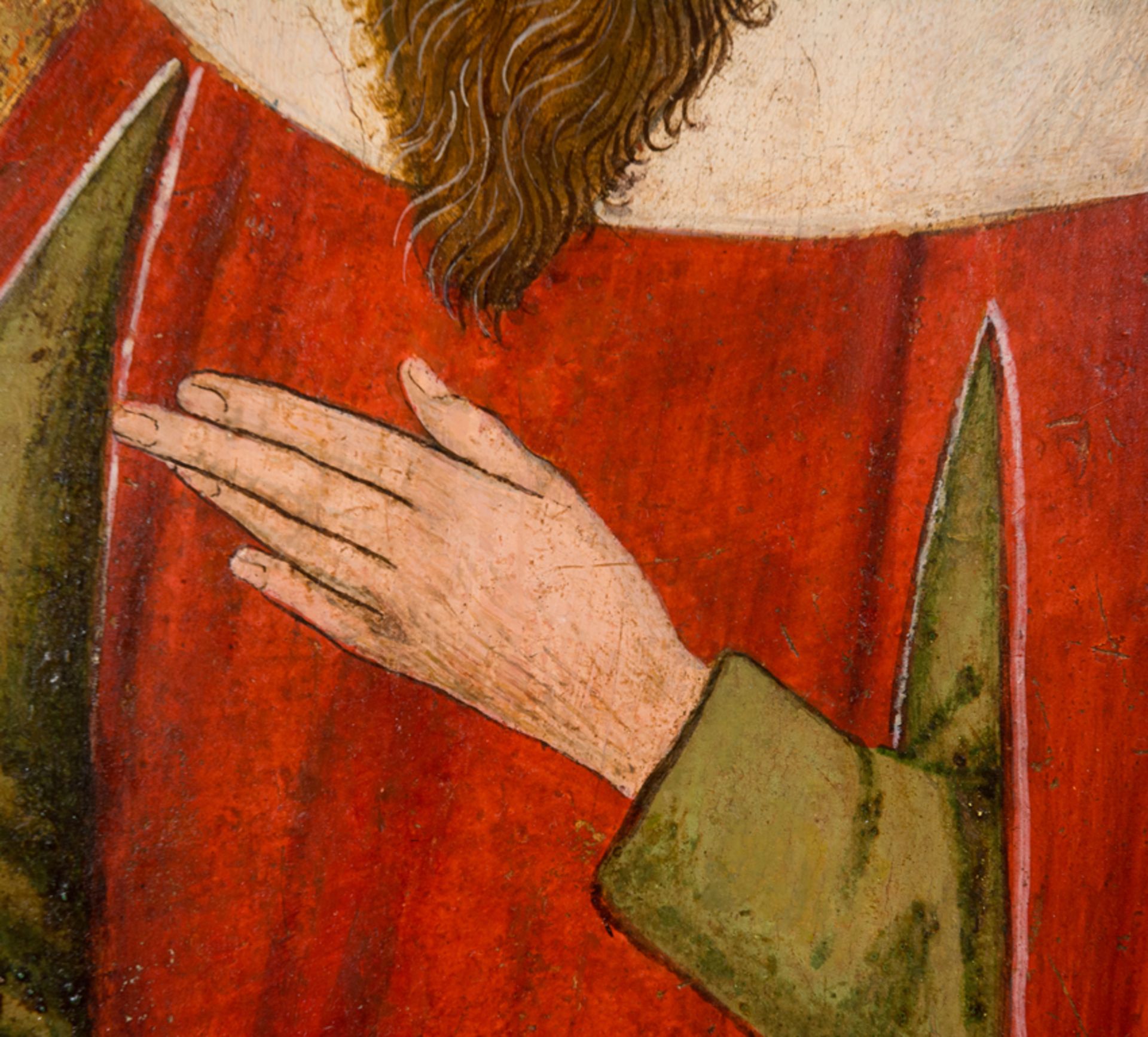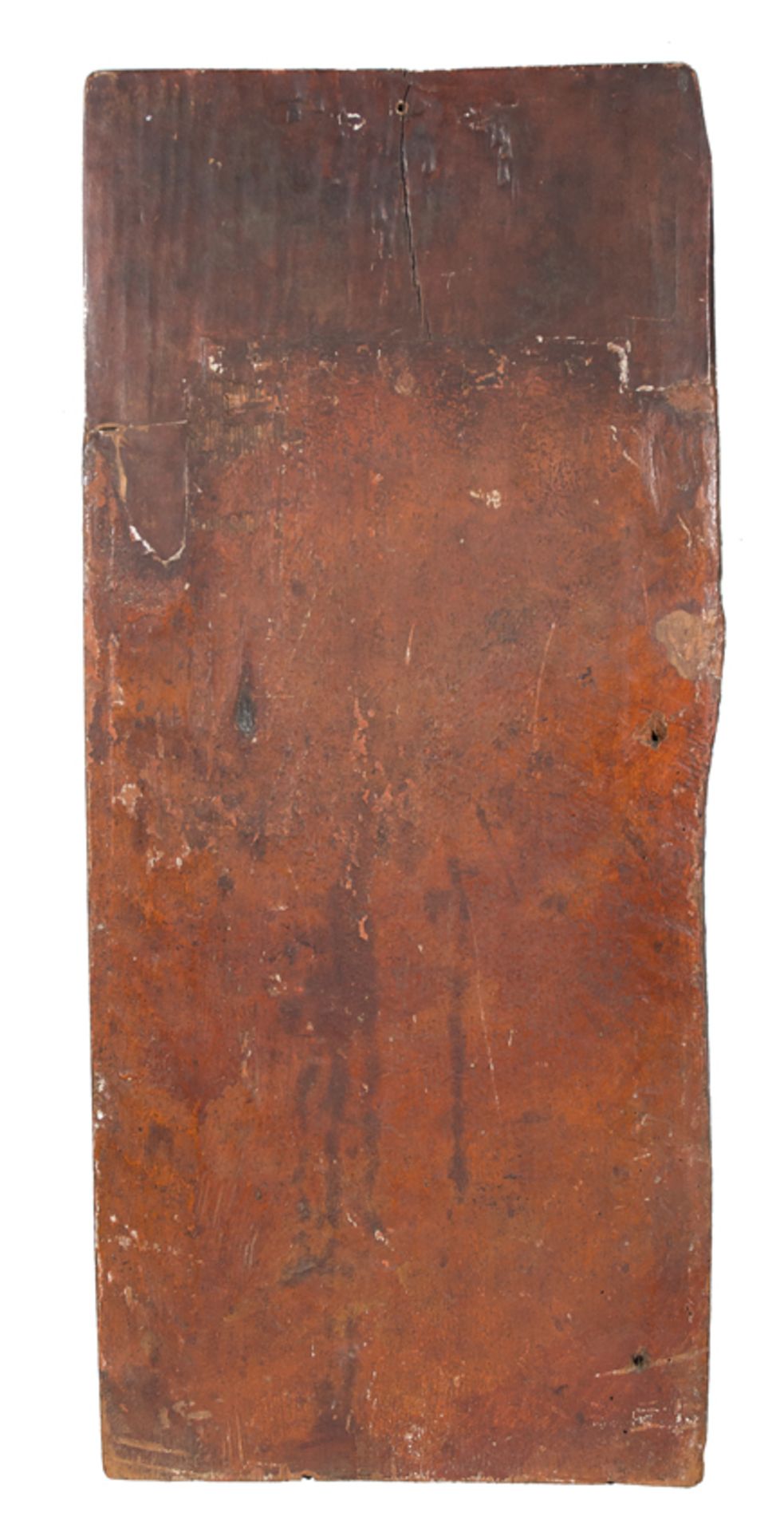7
Master of Saint George and the Princess. Zaragoza. Circa 1460-1470
Master of Saint George and the Princess. Zaragoza, circa 1460-1470
"The Prophet Zacharia"
Panel painting in tempera. 82 x 36 cm.
According to Dr. Alberto Velasco Gonzàlez on this painting, it is the previously unknown fragment of a reredos, which, due to its style, must be attributed to the Master of Saint George and the Princess, one of the most important painters of the late Gothic in the Aragon area. The panel, of rectangular and elongated format, is a fragment of an altarpiece dust cover with the representation of an almost full-length character in a three-quarter position. There is a small fragmentary tablet (30 x 26 cm) with a depiction of the prophet Daniel which is kept in the Prado Museum, which is not only relevant due to its iconography, but also because it is the work of the same painter who made the panel we have here.
Stylistically, the Prophet Zechariah offers no doubt as to the artist who painted him. This is undoubtedly a work by the Master of Saint George and the Princess, one of the most interesting painters of the late Gothic period in Aragon.
Among the works currently attributed to him are close parallels that justify this attribution. The best of them, surely, is the aforementioned Prophet Daniel from the Prado Museum. The parallels that could be pointed out are many and diverse, such as, for example, the fact that the facial features are completely identical, even in such secondary details as the black lines that can be observed around the lips, or the flashes of light made with fine brush strokes. In white near the tear duct of the eyes and by the nose. We also see the same type of prominent nose, somewhat sharper in the case of Daniel, or the summary depiction of the ear that is mostly covered up. The painter’s characteristic half-open eyes are found in both cases, brown and with a marked black pupil, and there is also the same treatment of the flesh. Finally, we see that the way of representing the eyebrows is repeated, through short brushstrokes that define the hairs.
This confirmed identity also occurs in the painter’s best-known work, the panel of Saint George and the Princess which is kept in the Museu Nacional d'Art de Catalunya, where we detect an absolute coincidence in the styles previously noted. The same can be said for the two panels painted on both sides that were part of the same set, and which were kept in Berlin until 1945, when they were destroyed. In them we find different faces whose characteristics refer us directly to those of the Prophet Zechariah, as is the case of Saint Paul or to Saint John the Baptist.
We can also mention the Saint Sebastian currently kept Gaasbeek Castle (Lennik, Belgium), which also has a human figure similar to that of our Prophet Zechariah, with his ear half-hidden behind his hair, a rounded nose and a troubled look.
The painter: The Master of Saint George and the Princess
To date, little is known about the painter. Neither his name nor the city he must have worked from, although it can be assumed that it must have been Zaragoza, the main artistic hub of Aragon in Gothic times. We do know, however, that he carried out one of his commissions for the monastery of San Pedro de Siresa (Huesca), located in the heart of the Pyrenees. We also know that he worked for the Cabrera family, an important lineage with origins in Catalonia. He created the work that gives the painter his name for a member of this family, the Altarpiece of Saint George and the Princess, of which only one compartment is preserved, in the Museu Nacional d'Art de Catalunya, although through old photographs we know of others that were burned in a fire in 1945 in the Kaiser Friedrich Museum in Berlin.
The painter’s great critical acclaim has been earned by an emblematic work which has been the focus of texts written about the artist by specialists and also a good part of what was written up to a certain point in time about late Gothic painting in Catalonia. We refer to the aforementioned Saint George and the Princess kept in the Museu Nacional d'Art de Catalunya, which came to light for the first time in 1884 and was attributed to Jaume Huguet in 1909.
It is in the attribution of Saint George and the Princess to Jaume Huguet that the historiographic significance that the work and its author have had lies. Over time, the panel gained prestige among specialists and became a particularly representative painting of the art of Huguet, one of the emblematic Gothic painters of Catalonia.
Jaume Huguet's Aragonese journey was a novelty in the artist's historiography, and conditioned the study of Aragonese painting in the following decades. The formal relations between Aragonese and Catalan late-Gothic painting have drawn the attention of specialists for some time, although it must be said that for much of the 20th century a mistaken interpretative paradigm prevailed, as it was considered that Huguet had a decisive influence on a large group of active painters in Zaragoza and Huesca through the works he carried out in Aragon. He was introduced to the main focus of Catalan painting in the second half of the 15th century and a large proportion of the painters active in Aragon at that time were also placed under his influence.
As we can see, the proposal not only implied attributing a series of works to Huguet, but also assumed that a good part of Aragonese painting in the second half of the 15th century was influenced by him.
But time ended up resolving these issues, finally, and what Post had already supposed in 1938 was demonstrated, and affirmed more forcefully in 1941: that the Altarpiece of Saint George and the Princess was not the work of Jaume Huguet, but of an Aragonese painter who was certainly stylistically connected with the Catalan context. The American specialist mistakenly attributed the altarpiece to Martín de Soria, a documented master in Zaragoza between 1449 and 1487. The art historian Joan Sureda took up Post's theory and it was he who in 1991 proposed removing the Aragonese works and the Altarpiece of Saint George and the Princess from Huguet’s catalogue.
More recently, there has been a growing agreement about the attribution of the work to the Master of Saint George and the Princess, who is gradually being revealed as one of the key characters around which Aragonese painting pivoted in the second half of the 15th century.
He is a master who shows subtlety in capturing certain details and a certain skill in the representation of emotion, an aspect that makes him stand out among his contemporaries.
After this long historiographical journey of more than one hundred years, the catalogue of works by the Master of Saint George and the Princess has only been established in three sets of works. As has already been mentioned, the most important was the Altarpiece of Saint George and the Princess, which the painter must have made for a member of the Cabrera family, to which the aforementioned prophet Daniel from the Prado National Museum must have been added, as well as the panels with Saint John the Baptist and Saint James the Elder kept in the church of the monastery of San Pedro de Siresa. It is important to note that the two Siresa panels are preserved in the place for which they were painted, which is an important further argument when it comes to justifying the Aragonese origin of their author.
Provenance: France - Barcelona private collection (2021).
We would like to thank Dr. Alberto Velasco González for identifying and cataloguing this painting.
The lot includes Dr. Alberto Velasco Gonzàlez’s report.
Master of Saint George and the Princess. Zaragoza, circa 1460-1470
"The Prophet Zacharia"
Panel painting in tempera. 82 x 36 cm.
According to Dr. Alberto Velasco Gonzàlez on this painting, it is the previously unknown fragment of a reredos, which, due to its style, must be attributed to the Master of Saint George and the Princess, one of the most important painters of the late Gothic in the Aragon area. The panel, of rectangular and elongated format, is a fragment of an altarpiece dust cover with the representation of an almost full-length character in a three-quarter position. There is a small fragmentary tablet (30 x 26 cm) with a depiction of the prophet Daniel which is kept in the Prado Museum, which is not only relevant due to its iconography, but also because it is the work of the same painter who made the panel we have here.
Stylistically, the Prophet Zechariah offers no doubt as to the artist who painted him. This is undoubtedly a work by the Master of Saint George and the Princess, one of the most interesting painters of the late Gothic period in Aragon.
Among the works currently attributed to him are close parallels that justify this attribution. The best of them, surely, is the aforementioned Prophet Daniel from the Prado Museum. The parallels that could be pointed out are many and diverse, such as, for example, the fact that the facial features are completely identical, even in such secondary details as the black lines that can be observed around the lips, or the flashes of light made with fine brush strokes. In white near the tear duct of the eyes and by the nose. We also see the same type of prominent nose, somewhat sharper in the case of Daniel, or the summary depiction of the ear that is mostly covered up. The painter’s characteristic half-open eyes are found in both cases, brown and with a marked black pupil, and there is also the same treatment of the flesh. Finally, we see that the way of representing the eyebrows is repeated, through short brushstrokes that define the hairs.
This confirmed identity also occurs in the painter’s best-known work, the panel of Saint George and the Princess which is kept in the Museu Nacional d'Art de Catalunya, where we detect an absolute coincidence in the styles previously noted. The same can be said for the two panels painted on both sides that were part of the same set, and which were kept in Berlin until 1945, when they were destroyed. In them we find different faces whose characteristics refer us directly to those of the Prophet Zechariah, as is the case of Saint Paul or to Saint John the Baptist.
We can also mention the Saint Sebastian currently kept Gaasbeek Castle (Lennik, Belgium), which also has a human figure similar to that of our Prophet Zechariah, with his ear half-hidden behind his hair, a rounded nose and a troubled look.
The painter: The Master of Saint George and the Princess
To date, little is known about the painter. Neither his name nor the city he must have worked from, although it can be assumed that it must have been Zaragoza, the main artistic hub of Aragon in Gothic times. We do know, however, that he carried out one of his commissions for the monastery of San Pedro de Siresa (Huesca), located in the heart of the Pyrenees. We also know that he worked for the Cabrera family, an important lineage with origins in Catalonia. He created the work that gives the painter his name for a member of this family, the Altarpiece of Saint George and the Princess, of which only one compartment is preserved, in the Museu Nacional d'Art de Catalunya, although through old photographs we know of others that were burned in a fire in 1945 in the Kaiser Friedrich Museum in Berlin.
The painter’s great critical acclaim has been earned by an emblematic work which has been the focus of texts written about the artist by specialists and also a good part of what was written up to a certain point in time about late Gothic painting in Catalonia. We refer to the aforementioned Saint George and the Princess kept in the Museu Nacional d'Art de Catalunya, which came to light for the first time in 1884 and was attributed to Jaume Huguet in 1909.
It is in the attribution of Saint George and the Princess to Jaume Huguet that the historiographic significance that the work and its author have had lies. Over time, the panel gained prestige among specialists and became a particularly representative painting of the art of Huguet, one of the emblematic Gothic painters of Catalonia.
Jaume Huguet's Aragonese journey was a novelty in the artist's historiography, and conditioned the study of Aragonese painting in the following decades. The formal relations between Aragonese and Catalan late-Gothic painting have drawn the attention of specialists for some time, although it must be said that for much of the 20th century a mistaken interpretative paradigm prevailed, as it was considered that Huguet had a decisive influence on a large group of active painters in Zaragoza and Huesca through the works he carried out in Aragon. He was introduced to the main focus of Catalan painting in the second half of the 15th century and a large proportion of the painters active in Aragon at that time were also placed under his influence.
As we can see, the proposal not only implied attributing a series of works to Huguet, but also assumed that a good part of Aragonese painting in the second half of the 15th century was influenced by him.
But time ended up resolving these issues, finally, and what Post had already supposed in 1938 was demonstrated, and affirmed more forcefully in 1941: that the Altarpiece of Saint George and the Princess was not the work of Jaume Huguet, but of an Aragonese painter who was certainly stylistically connected with the Catalan context. The American specialist mistakenly attributed the altarpiece to Martín de Soria, a documented master in Zaragoza between 1449 and 1487. The art historian Joan Sureda took up Post's theory and it was he who in 1991 proposed removing the Aragonese works and the Altarpiece of Saint George and the Princess from Huguet’s catalogue.
More recently, there has been a growing agreement about the attribution of the work to the Master of Saint George and the Princess, who is gradually being revealed as one of the key characters around which Aragonese painting pivoted in the second half of the 15th century.
He is a master who shows subtlety in capturing certain details and a certain skill in the representation of emotion, an aspect that makes him stand out among his contemporaries.
After this long historiographical journey of more than one hundred years, the catalogue of works by the Master of Saint George and the Princess has only been established in three sets of works. As has already been mentioned, the most important was the Altarpiece of Saint George and the Princess, which the painter must have made for a member of the Cabrera family, to which the aforementioned prophet Daniel from the Prado National Museum must have been added, as well as the panels with Saint John the Baptist and Saint James the Elder kept in the church of the monastery of San Pedro de Siresa. It is important to note that the two Siresa panels are preserved in the place for which they were painted, which is an important further argument when it comes to justifying the Aragonese origin of their author.
Provenance: France - Barcelona private collection (2021).
We would like to thank Dr. Alberto Velasco González for identifying and cataloguing this painting.
The lot includes Dr. Alberto Velasco Gonzàlez’s report.
"On Prophets, Saints and Princesses"
Sale Date(s)
Venue Address
General delivery information available from the auctioneer
The purchase price includes the delivery of the lots in the venue of the auction. Transporting to other destinations is at the own risk of the client. The customer must contact "LST", to give the corresponding instructions for such transporting. "LST" is not responsible for the packaging or any accident incurred during transportation.
Important Information
Aufgeld / Premium: 22 %
Live: 3 %
jeweils plus 21 % USt. / each plus 21 % VAT
Terms & Conditions
CONDITIONS OF THE AUCTION:
I. REGISTRATION. To bid in the room customers must register at the beginning, filling out a form and picking a number that will identify them during the auction. Customers may be required to register in bank references or other guarantee system and if they do not prove the solvency "LST" will not accept bids and award the auction.
II. WRITTEN BIDS. "LST" will accept written bids, which will be formalized in the form provided by the room until the day before the auction. In such auctions, the room will bid in name of the client until the maximum stated in the offer and always at the lowest possible price. If there are two or more bids for the same amount, the one placed first will have the priority. Written bids received in advance, will have priority on the day of the auction.
III. TELEPHONE BIDS. "LST" will allow telephone bids, if interested people contact "LST" days before the auction providing personal data, ID card and the phone number which will be used by the staff of "LST" to call at the time of the auction. The buyer, within all the legal rights is making an offer for the asking price, when applies for telephone bid. "LST" will not take responsibility for any technical defects beyond its control, which may prevent to contact successfully the bidder during the auction.
IV. AUCTIONEER. The auction will be conducted by an auctioneer, director of the auction will be judge and arbitrator of it with full authority in its development, will award the lots to the highest bidder and is able to settle any controversy concerning lots sale, reject bids, divide lots or group them and remover objects from the room. Will be able to, if it is deemed suitable, not accept bids on the auction. His decision will be unappealable.
V. SALE OF LOTS. The lots are awarded to the highest bidder. Once the auctioneer blows the hammer, the buyer becomes responsible of the lot purchased, exempting "LST" of liability to for any damage and / or accidents that may occur. No refunds of lots.
VI. STARTING PRICE. The amount shown in the catalogue as the starting price for each lot will be, as a rule, the minimum selling price, except for exceptional cases where a reservation may be agreed upon with the seller or it set discretionary by the room.
VII. SCALE OF BIDS. The bids are set according to the following scale:
From 50.-€ to 200.-€…………………………………………..at 10.-€
From 200.-€ to 500.-€…………………………………… …25 in 25.-€
From 500.-€ to 1.000.-€………………………………..…..….50 in 50.-€
From 1.000.-€ to 2.000.-€………………………………..…100 in 100.-€
From 2.000.-€ to 5.000.-€……………………………….….250 in 250.-€
From 5.000.-€ to 10.000.-€…………………………………500 in 500.-€
From 10.000.-€ to 20.000.-€……………………………1.000 in 1.000.-€
From 20.000.-€ to 50.000.-€……………………………2.500 in 2.500.-€
From 50.000.-€ to 100.000.-€…………………………..5.000 in 5.000.-€
From 100.000.-€ to 100.000.-€………………………10.000 in 10.000.-€
From 200.000.-€ to 200.000.-€………………………25.000 in 25.000.-€
From 500.000.-€ to 500.000.-€………………………50.000 in 50.000.-€
VIII. RIGHT OF ADMISION. "LST" reserves the right to admission to the auction room and to reject, at its judgment, any purchase order, from clients whose solvency is not duly proved as well as not to sale auctions.
IX. SALE PRICES. The successful bidder of one or more lots must pay "LST" the final sale price achieves at auction, plus the 22 % plus 21% VAT on the commission, at total 26,62 % on Hammer Price.
X. CATALOG DATA. The catalogue data are obtained in order to careful research and advice, however, any responsibility is afforded about its accuracy. The lots will be auctioned in the state in which they are, not accepting any claims in restorations, breakage, damage, imperfections and, even description or numbering mistakes in the catalogue, in case of it, being the burden of the buyers to make sure before the auction that the description matches with their personal opinion about respective lot. The exhibition of the lots is intended to allow a perfect review and study of them.
XI. PAYMENT AND REMOVAL OF LOTS. Payment and removal of the lots will be held no later than five days following the auction. After this period expire without having the buyer removed the lot or lots purchases, it will accrue an expense of custody of 6 euros per day on each lot.
15 days after the auction without having the buyer paid and removes the sold lots, "LST" will inform the seller and there will begin judicial proceeding in order to obtain payment. The delay in payment by the purchaser of his/her sold lots will carry an interest increase at a rate of 1,5% per month.
XII. DELIVERY OF LOTS. The purchase price includes the delivery of the lots in the venue of the auction. Transporting to other destinations is at the own risk of the client. The customer must contact "LST", to give the corresponding instructions for such transporting. "LST" is not responsible for the packaging or any accident incurred during transportation.
XIII. RIGHT OF FIRT REFUSAL AND REPURCHASE. "LST" in order to article 38 of "Ley 16/1985 de 25 Junio del Patrimonio Histórico Español" (BOE. 155 June 29, 1985), will notify in advance to the Ministry of Culture, the content of their catalogues. Concerning the lots subject to the legislation referred to in the preceding paragraph, the Administration may exercise the rights of first refusal and repurchase according to the law. "LST" will watch over the protection of Artistic, Historical and Bibliographical Heritage of Spain. For customers out of European Community, a tax for export is required by the Administration.
XIV. VALUE ADDED TAX (I.V.A). This tax will be accrued on commissions of "LST" for buyers, using the rates prevailing on the date of the auction.
XV. DATA PROTECTION. In order to the "Ley 15/1999 de 13 de Diciembre, de Protección de Datos de Carácter Personal", the client authorize "LST", the inclusion of their data in a customer file, and for the promotion by "LST" of the objects at all times the rights of access, rectification or deletion of personal data by sending the appropriate request to the following address: LA SUITE SUBASTAS, C/ Conde Salvatierra, 8, 08006. Barcelona.
XVI. EXPRESS LEGAL JURISDICTION. These Conditions are governed by and interpreted in accordance with the rules of Spanish law. The mere act of participating in the auction as seller, buyer or bidder, implies acceptance of these Terms and Conditions.
Sales operations are understood to be held at the registered office of "LST", C/ Conde de Salvatierra, 8, 08006. Any dispute shall be taken to the competent courts of Barcelona, expressly waiving any other jurisdiction, in accordance with Article 55 of the "Ley de Enjuiciamiento Civil".












